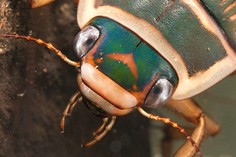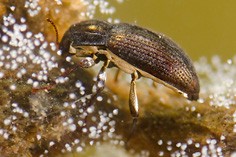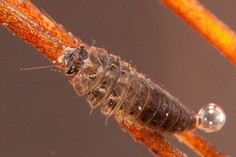Water beetles (order Coleoptera)
Contained families:
Dytiscidae (Diving beetles)
Hydrophilidae (Water scavenger beetles)
Haliplidae (Crawling water beetles)
Gyrinidae (Whirligig beetles)
Scirtidae (Marsh beetles)
Elmidae (Riffle beetles)
![]()

Diving beetles
(order Coleoptera, family Dytiscidae)
Feeding:
Both larvae and adults are predators.
Habitat:
Diving beetles can be found in almost any freshwater habitat. They are common in temporary pools, wetlands, marshes, ponds and slow sections of flowing waters.
Movement:
Swimmers using hind legs as oars.
Size:
Size of the adult diving beetles varies from 2 mm to 45 mm.
Life cycle:
Diving beetles undergo complete metamorphosis. Their life cycle includes four stages – egg, larva, pupa and adult. Most species produce one generation per year. Some live up to 2 – 3 years as adults.
Introduction:
In diversity, Coleoptera is the largest order of insects (containing more than 400 000 described species) and one of the largest groups of animals on Earth. One third of all insects belongs to this single order.
Even though most beetles are terrestrial, many of them have colonized freshwater habitats and spend at least one of their life stages as aquatic. Beetles entered aquatic environment after millions of years evolving on land, yet they can be found in almost any freshwater habitat. The greatest diversity is reached in still waters such as ponds, wetlands, billabongs, or in slow flowing waters with lot of vegetation. Adults and larvae rely on atmospheric oxygen, therefore can be found even in habitats with low level of dissolved oxygen.
Diving beetles may look very similar to their terrestrial relatives, but dytiscids have developed some modifications, which enable them to be so successful and diverse. In general, the body is more streamlined in shape and flattened (compared to terrestrial beetles). Hind legs are equipped with dense rows of swimming hairs. The hairy fringes spread out on the power stroke, which increase the surface area. On the return stroke they bend in to reduce water resistance. Other four legs are trucked into grooves along the sides to preserve streamlined body shape. These adaptations make dytiscids exceptionally efficient swimmers.
As like in terrestrial beetles, all the body is well armored. Forewings are modified into hardened covering (elytra), which protects the top of abdomen and the second pair of membranous wings. Head, thorax and bottom side of the abdomen are hardened (sclerotized) as well. It is advantage over other invertebrates, protecting the beetles from predators and mechanical damage.
Moreover, diving beetles kept the ability to fly and thus colonize new locations. They use light reflections from the water surface to detect new habitats. This takes place when the competition for food is too high, when looking for mates, or if conditions in the habitat dramatically change (becomes polluted, dries out, freezes).
Some large species live up to several years and move to larger water bodies to overwinter. Habitats, where the water does not freeze all the way to the bottom, give them a chance to hibernate in plant material and sediments at the bottom.
Beetles mostly hide in aquatic vegetation or rest just under the water, with the tip of abdomen in contact with the surface. Diving beetles breathe atmospheric oxygen, so they have to carry air supply when venture deeper into the water. There is a cavity under the elytra, where the air is stored.
Spiracles (openings to the respiratory system) are placed on the top of the abdomen and enter the cavity. In contrast to terrestrial beetles, having spiracles placed mostly on the sides of the body. Even though air bubble acts as a physical gill, allowing the insects to extract oxygen directly from the water, it must be replaced time to time by breaking the surface tension of the water. Diving beetles hence their common name according to this behavior. Dytiscids use the tip of abdomen to break the water tension and replenish the air supply.
The head bears a pair of antennae and well developed eyes, which are not strongly protuberant. Chewing mouthparts are used to tear pieces off their prey, which is captured with the tarsal claws. Diving beetles feed on other insects, crustaceans, tadpoles, snails and small fish. Adults will also feed on any carrion they find.
As already mentioned, beetles undergo complete metamorphosis. Their life cycle includes four stages: egg, larva, pupa and adult. Females lay eggs on various submerged objects or in the masses of vegetation. Dytiscids often deposit eggs into stems of aquatic plants by making the cuts in plant tissue.
Both larvae and adults of diving beetles are aquatic. Young larvae hatch in few weeks and obtain oxygen by diffusion through the entire body surface. Later, they breathe atmospheric oxygen by spiracles placed on the tip of the abdomen. In order to breathe continuously, larvae often position themselves with the tip of abdomen in contact with the surface. Many dytiscid larvae have a pair of caudal filaments, which help to break the water tension.
Larvae have elongated body and can be distinguished by the presence of sclerotized head, distinct neck, three pairs of segmented legs and prominent mandibles. Larvae lack wing pads, prolegs and outgrowing tracheal gills. They mostly climb among aquatic vegetation or crawl in the sediments of shallow waters. One or more pairs of legs may be equipped with hairs for swimming.
Larvae are active and voracious predators attacking invertebrates and all other animals that are smaller than they are (including fish and amphibians). No exception is that the larvae feed on adult beetles. Larvae of some large species can reach sizes up to 60 mm, making them one of the largest invertebrate predators. They often have closed mouth openings and use channels in their large (sickle-like) mandibles to inject digestive enzymes into the prey. Enzymes quickly paralyze and kill the victim. Dissolved and partially digested body fluids are then sucked out by the larvae. Only the empty, crumpled skins of their prey are left behind.
Larvae molt usually three times to become fully grown. When the larval development is completed, they leave the water and dig a cellar in a damp soil to pupate. Transformation into adult takes few weeks and adult stays within the cavity some additional time as the skin hardens. Colorful and shiny adult beetles crawl out of the soil and their first flight often leads back into the water.
Larvae in northern hemisphere leave the water in late summer. Adults emerge from the pulpal cells in the fall. Adult beetles overwinter and do not mate and lay eggs until the next spring.
Great diving beetle (Dytiscus marginalis)
Great diving beetle (Dytiscus marginalis) larvae
Lesser diving beetle (Acilius sulcatus)
Lesser diving beetle (Acilius sulcatus) larvae
Lesser diving beetle (Graphoderus cinereus)
Lesser diving beetle (Graphoderus sp.) larvae
Diving beetle (Hyphydrus ovatus)
Diving beetle (Hyphydrus ovatus) larvae
Diving beetle (Platambus maculatus)
Diving beetle (Platambus maculatus) larvae
Diving beetle (Rhantus suturalis)
Diving beetle (Colymbetes fuscus)
Diving beetle (Hydroporus palustris)
Diving beetle (Agabus sp.)
Diving beetle (Laccophilus hyalinus)
Diving beetle (Cybister lateralimarginalis)
Diving beetle (Cybister lateralimarginalis) larvae
Diving beetle (Deronectes latus)
 Water scavenger beetles
Water scavenger beetles
(order Coleoptera, family Hydrophilidae)
Feeding:
Larvae are almost entirely predaceous. Adults are collectors, gatherers, or predators.
Habitat:
Water scavenger beetles can be found in almost any aquatic habitat, including temporary pools, wetlands, marshes, ponds and slow sections of flowing waters.
Movement:
Swimmers using middle and hind pairs of legs as oars.
Size:
Adult beetles of some species reach sizes up to 45 mm.
Life cycle:
Water scavenger beetles undergo complete metamorphosis. Their life cycle includes four stages – egg, larva, pupa and adult. Most species produce one generation per year. Some live up to 2 – 3 years as adults.
Introduction:
In the term of diversity, Hydrophilidae is the second largest family of water beetles (overtaken by Dytiscidae). Beetles of both families may occur in the same habitats, thus are often collected simultaneously. Adult beetles are similar in size and shape, but hydrophilids can be distinguished by:
– Characteristically clubbed antennae, which are mostly composed under the head.
– Hydrophilids have more convex top and more flattened bottom of the body.
– Presence of thin layer of air on the bottom of the body.
– Most species have a conspicuous, sharp pointed keel between the legs.
– Hydrophilids perform alternating movement of legs (diving beetles swim simultaneously).
– To replenish the air supply, water scavenger beetles break the water tension head first (diving beetles use the tip of abdomen).
In general, water scavenger beetles feed on decaying organic matter, but eat considerable amount of living invertebrates as well. As their common name suggests, adult beetles are often observed as scavenging on carrions of fish and amphibians.
The bottom of the body is covered with small hydrophobic hairs, which are able to maintain a layer of additional air between the water and the body. Thanks to this adaptation, a scavenger beetle can stay under the water for a long time.
Larvae are almost entirely carnivorous and search for prey for most of the time. These voracious predators consume any kind of living organisms that they get caught with robust and serrated mandibles. Larvae sometimes drag aquatic animals out of the water to immobilize them. Larvae breathe atmospheric oxygen through the spiracles, which are placed on the tip of abdomen. However, some larvae have developed branched gills in order to enhance breathing efficiency.
Lesser silver water beetle (Hydrochara caraboides)
Lesser silver water beetle (Hydrochara caraboides) larvae
Great silver water beetle (Hydrophilus piceus)
Water scavenger beetle (Spercheus emarginatus)
Water scavenger beetle (Helochares obscurus)
 Crawling water beetles
Crawling water beetles
(order Coleoptera, family Haliplidae)
Feeding:
Shredders feeding mostly on plant material and algae, but some species are carnivorous.
Habitat:
Crawling water beetles inhabit lakes, ponds, marshes and slow sections of flowing waters.
Movement:
Crawlers/climbers/swimmers – beetles mostly crawl on the bottom of shallow waters or climb among aquatic vegetation. If needed, they can clumsily swim by alternate strokes with their legs.
Size:
Size of the adult diving beetles varies from 2 mm to 6 mm.
Life cycle:
Crawling water beetles undergo complete metamorphosis. Their life cycle includes four stages – egg, larva, pupa and adult.
Other characteristics:
Crawling water beetles breathe from the bubble of air, which is stored under the elytra. Additional air supply is kept under the flattened coxal plates, which partially cover the first segment of hind legs. This increase of air maintains buoyancy and enables the beetle to rise simply to the surface to get fresh air, rather than swim or crawl. Usually yellowish or brownish body is small and oval, covered with rows of small indentations on the top.
Crawling water beetles (Haliplidae)
Crawling water beetle (Haliplidae) larvae
 Whirligig beetles
Whirligig beetles
(order Coleoptera, family Gyrinidae)
Feeding:
Predators feeding mostly on insects trapped on the water surface.
Habitat:
Whirligig beetles are found on the water surface of ponds and slow sections of streams and rivers.
Movement:
Swimmers using middle and hind pairs of legs as oars. Whirligig beetles swim exceptionally fast in circles.
Size:
Adult beetles of some species reach sizes up to 20 mm.
Life cycle:
Whirligig beetles undergo complete metamorphosis. Their life cycle includes four stages – egg, larva, pupa and adult.
Other characteristics:
Whirligig beetles are sensitive to water ripples, which reveal the location of potential prey. Moreover, they create their own vibrations and process the returning echoes to detect prey or find mates. Whirligig beetles possess unique adaptation in the form of horizontally divided eyes. They can see both under and above the water at the same time.
Whirligig beetles (Gyrinidae)
 Riffle beetles
Riffle beetles
(order Coleoptera, family Elmidae)
Feeding:
Scrappers/collectors/gatherers feeding mostly on detritus and periphyton (layer of algae and associated flora and fauna).
Habitat:
Riffle beetles live in habitats with high levels of dissolved oxygen, therefore are found in fast sections of cold streams and rivers.
Movement:
Clingers using large tarsal claws to maintain in the current. They move very slowly.
Size:
Size of the adult riffle beetles varies from 1 mm to 8 mm.
Life cycle:
Riffle beetles undergo complete metamorphosis. Their life cycle includes four stages – egg, larva, pupa and adult. Some species live up to 5 years.
Other characteristics:
Elmids are small, dark colored beetles with metallic luster. Their elytra possess rows of small indentations. Legs are long (compared to the body). Microscopic hairs on the bases of legs and bottom of the body repel the water and hold layer of air. This plastron is so efficient, that most riffle beetles never have to replenish the air by the surface. Elongated, cylindrical larvae have tufts of gills on the last abdominal segment. Gills can be withdrawn into the body cavity to protect them from abrasion in a fast current.
Riffle beetles (Elmidae)
Riffle beetle (Elmidae) larva
 Marsh beetle larva
Marsh beetle larva
(order Coleoptera, family Scirtidae)
Marsh beetle (Scirtidae) larva






























































































































































































































